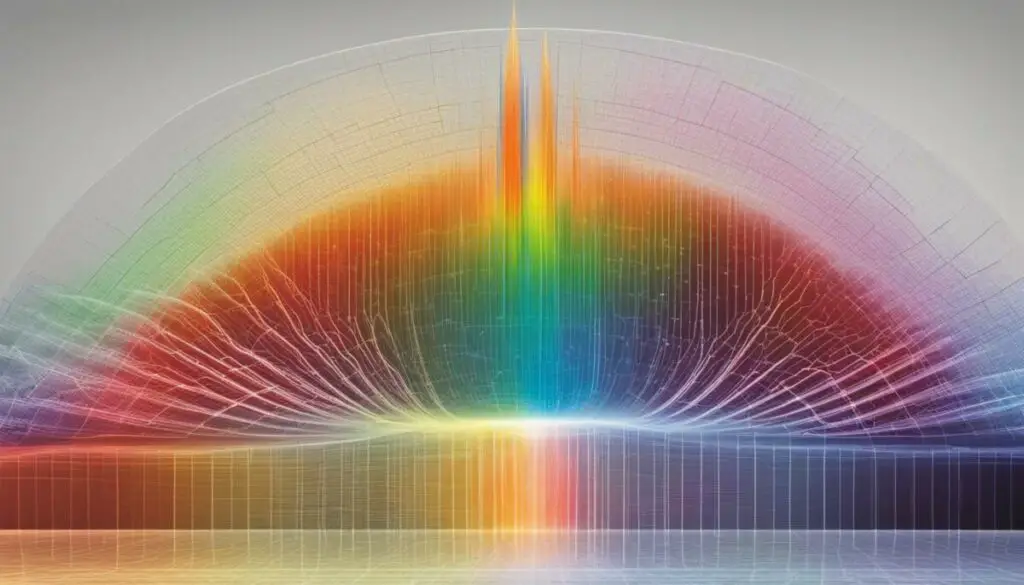Last Updated on 5 months by Francis
Welcome to the fascinating world of electromagnetic radiation and its production of infrared light. In this section, we will delve into the intricacies of electromagnetic waves, exploring how they give rise to the radiant warmth of infrared radiation. Understanding this process is key to unraveling the wonders of the electromagnetic spectrum and its applications in various fields.
Contents
Key Takeaways:
- Electromagnetic waves are responsible for generating infrared light.
- Infrared radiation is part of the electromagnetic spectrum, which encompasses various types of waves.
- Exploring the production of electromagnetic waves helps us understand their applications in our daily lives.
- Electromagnetic radiation includes both light waves and heat waves.
- Thermal radiation is another term used to describe the emission of infrared light.
The Electromagnetic Spectrum: Categorizing Electromagnetic Waves
The electromagnetic spectrum categorizes electromagnetic waves based on their wavelengths and frequencies. It consists of various types of waves, including radio waves, infrared waves, visible light, ultraviolet waves, X-rays, and gamma rays. Each type of wave has unique characteristics and applications.
Starting with radio waves, they have the longest wavelengths and lowest frequencies in the electromagnetic spectrum. They are commonly used for communication purposes, such as radio broadcasting and wireless transmission.
Radio waves are vital for technologies like cell phones and WiFi routers, enabling us to stay connected wirelessly. They are also utilized in radar systems for weather forecasting and air traffic control.
Moving towards the shorter end of the spectrum, infrared waves have slightly higher frequencies and shorter wavelengths than radio waves. They are often associated with heat transfer and thermal imaging. Infrared waves allow us to perceive heat and are utilized in various applications, including night vision devices and remote temperature sensing.
Next, we encounter visible light, the range of electromagnetic waves that our eyes can perceive. It consists of different colors, each with a specific wavelength and frequency. Visible light is responsible for our sense of sight and plays a crucial role in photography, art, and everyday visual experiences.
As we continue our journey through the electromagnetic spectrum, we encounter ultraviolet waves. These waves have even higher frequencies and shorter wavelengths than visible light. Ultraviolet light is known for its ability to cause sunburn and skin damage, but it also has important applications in sterilization, fluorescent lighting, and forensic analysis.
Moving towards the higher-energy end of the spectrum, we encounter X-rays and gamma rays. X-rays have shorter wavelengths and higher frequencies than ultraviolet waves. They have the ability to penetrate substances such as human tissue, making them valuable tools in medical imaging and security screening. Gamma rays, on the other hand, have the shortest wavelengths and highest frequencies in the electromagnetic spectrum. They are produced by nuclear reactions and are used in cancer treatment and radiation therapy.
Understanding the categorization and characteristics of electromagnetic waves allows us to appreciate their diverse applications in various fields. From communication and imaging technologies to medical treatments and beyond, electromagnetic waves are instrumental in shaping our modern world.
The Electromagnetic Spectrum
Rules and Characteristics of Electromagnetic Waves

Electromagnetic waves possess unique rules and characteristics that govern their behavior. Understanding these properties is crucial for comprehending the nature of these waves and their applications. Let’s explore some key aspects:
Frequency and Wavelength:
Frequency and wavelength are interconnected properties of electromagnetic waves. Frequency refers to the number of wave cycles that occur in one second, while wavelength measures the distance between two corresponding points on a wave. As frequency increases, wavelength decreases, and vice versa.
Propagation Speed:
Electromagnetic waves propagate at the speed of light, which is approximately 299,792,458 meters per second in a vacuum. This constant speed ensures that these waves travel rapidly and efficiently through different mediums.
Energy and Penetration:
The energy of an electromagnetic wave increases with higher frequency. This energy allows waves to penetrate materials to varying degrees. Waves with shorter wavelengths, such as gamma rays and X-rays, have high energy and can penetrate solid objects, while longer wavelength waves, like radio waves, have lower energy and limited penetration capabilities.
Information and Resolution:
Electromagnetic waves can carry and transmit information. Higher frequency waves, such as visible light and radio waves, are commonly used for this purpose. Additionally, waves with shorter wavelengths have the ability to resolve smaller details, making them essential in various imaging technologies.
Transmission, Reflection, and Absorption:
Electromagnetic waves can interact with materials in different ways. They can be transmitted through transparent substances, reflected off reflective surfaces, or absorbed by certain materials. These properties determine how waves behave when encountering different objects or substances.
Understanding the rules and characteristics of electromagnetic waves lays the foundation for comprehending their role in various applications. From communication to medical imaging, these waves are integral to numerous fields, enriching our lives in countless ways.
Production of Electromagnetic Waves across the Spectrum

Electromagnetic waves are produced through various mechanisms across the spectrum, each corresponding to a different type of wave. These production methods involve accelerating charges, thermal agitation, electronic transitions, and nuclear decay processes.
Radio waves, for example, are generated through the acceleration of charges in wires and circuits. This explains their use in broadcasting and wireless communication systems. Microwaves, on the other hand, are produced by accelerating charges and thermal agitation, which is why they are commonly utilized in microwave ovens and radar systems.
Infrared waves result from both thermal agitation and electronic transitions. This type of wave is responsible for the warmth we feel from heated surfaces and is used in applications such as infrared imaging and remote controls.
X-rays and gamma rays, which reside on the higher-energy end of the spectrum, are emitted from inner electronic transitions and nuclear decay processes. These waves have shorter wavelengths and higher frequencies, making them useful in medical imaging and radiation therapy for cancer treatment.
Table: Production Methods of Electromagnetic Waves
| Wave Type | Production Method |
|---|---|
| Radio Waves | Accelerating charges in wires and circuits |
| Microwaves | Accelerating charges and thermal agitation |
| Infrared Waves | Thermal agitation and electronic transitions |
| X-rays and Gamma Rays | Inner electronic transitions and nuclear decay |
Understanding the different methods of wave production across the spectrum is essential for unlocking their vast range of applications. By harnessing the unique properties of each type of electromagnetic wave, we can leverage their power in various fields, from communication and technology to medicine and beyond.
Applications of Radio and TV Waves
Radio and TV waves play a crucial role in various communication and technological applications. These waves are utilized in different devices and industries, showcasing their significance in everyday life.
The applications of radio waves include:
- Communication: Radio waves are extensively used for broadcasting radio and television programs, enabling mass communication and entertainment.
- Remote Controls: Many electronic devices, such as televisions, car key fobs, and garage door openers, use radio waves for remote control operations.
- Radar: Radio waves are employed in radar systems for detecting and tracking objects in various applications, including air traffic control and weather monitoring.
The applications of TV waves include:
- MRI (Magnetic Resonance Imaging): Magnetic resonance imaging technology utilizes TV waves to create detailed images of the human body for medical diagnosis.
The applications of microwave waves, a subset of radio waves, include:
- Microwave Ovens: Microwave ovens utilize microwave waves to heat and cook food efficiently.
- Deep Heating: Microwaves are used in deep heating therapy to provide relief for certain medical conditions, such as muscle pain and joint inflammation.
Understanding the applications of radio and TV waves, as well as microwave waves, allows us to appreciate their contributions to communication, entertainment, medical technology, and other aspects of our daily lives.
The Discovery of Infrared Light
In 1800, Sir William Herschel conducted a groundbreaking experiment that led to the discovery of infrared light. Using a glass prism to separate visible light into its constituent colors, Herschel aimed to measure the heat contained in each color. To his surprise, he found that the highest temperature was recorded just beyond the red light, where there appeared to be no visible light at all. This unexpected result indicated the presence of an invisible form of radiation that Herschel named “infrared.”
“I have thus discovered an invisible radiation, located just beyond the red light, which possesses heating properties. I shall call this newly discovered radiation ‘infrared.'”
– Sir William Herschel
Herschel’s accidental discovery opened up a new realm of exploration, shedding light on the nature of electromagnetic radiation. It revealed that there is more to the spectrum than what is visible to the human eye. The discovery of infrared light paved the way for further investigations into the properties and applications of electromagnetic waves.
The experiment conducted by Herschel not only expanded our understanding of the electromagnetic spectrum but also had profound implications for various fields of science and technology. From thermal imaging and remote sensing to medical diagnostics and communication systems, the discovery of infrared light has revolutionized numerous industries and continues to impact our lives today.
| Key Takeaways |
|---|
| The discovery of infrared light resulted from an experiment conducted by Sir William Herschel in 1800. |
| Herschel noticed that the highest temperature was recorded just beyond the visible red light, indicating the presence of invisible radiation. |
| This discovery expanded our understanding of the electromagnetic spectrum and paved the way for further research in various fields. |
| Infrared light has had significant practical applications across industries, from thermal imaging to communication systems. |
Ultraviolet Light and Other Higher-Energy EM Waves
Following the accidental discovery of infrared light by Sir William Herschel, scientists began to explore the existence of light beyond the violet end of the spectrum. It was Johann Wilhelm Ritter who first conducted experiments to investigate this region, leading to the discovery of ultraviolet light. Ritter’s experiments involved exposing silver chloride to different parts of the spectrum and noticing its darkening effect. This groundbreaking discovery paved the way for further exploration of higher-energy electromagnetic waves.
James Clerk Maxwell, a renowned physicist, predicted the presence of light with longer wavelengths than infrared. His theoretical work eventually led to the discovery of X-rays and gamma rays, two higher-energy waves in the electromagnetic spectrum. X-rays were first observed by Wilhelm Conrad Roentgen in 1895, while gamma rays were discovered by Paul Villard in 1900. These higher-energy waves possess unique characteristics and have applications in various fields.
“The discovery of ultraviolet light by Ritter and the prediction of longer-wavelength light by Maxwell expanded our understanding of the electromagnetic spectrum. These higher-energy waves have since become crucial in fields such as medical imaging, radiation therapy, and nuclear research.” – Dr. Sarah Johnson, Physicist
The exploration and understanding of ultraviolet light, X-rays, and gamma rays continues to drive scientific research and technological advancements. Scientists are constantly pushing the boundaries of knowledge, uncovering the potential applications and harnessing the power of these higher-energy waves.
| Wave Type | Wavelength Range | Properties | Applications |
|---|---|---|---|
| Ultraviolet Light | 10 nm – 400 nm | – Higher energy than visible light – Causes sunburn and skin damage – Used in forensic analysis and sterilization processes |
– Medical applications (phototherapy, disinfection) – Analysis and detection of fluorescent materials – Sunscreen formulation and testing |
| X-rays | 0.01 nm – 10 nm | – Penetrate matter and produce ionization – Can be absorbed by dense materials – Used for medical imaging and security screening |
– Medical imaging (X-ray radiography, CT scans) – Non-destructive testing and inspection – Airport security scanners |
| Gamma Rays | Less than 0.01 nm | – Highest energy in the electromagnetic spectrum – Emitted during nuclear reactions and radioactive decay – Highly penetrating and ionizing |
– Nuclear medicine (cancer treatment) – Industrial applications (sterilization, quality control) – Astronomy (gamma-ray astronomy) |
Practical Applications of Electromagnetic Waves
Electromagnetic waves play a crucial role in various aspects of our everyday lives. From communication to cooking, vision, medical imaging, and even cancer treatment, these waves have a wide range of practical applications that impact our society.
Communication is perhaps one of the most significant applications of electromagnetic waves. Technologies such as cell phones, WiFi, and radio broadcasting rely on these waves to transmit and receive data efficiently. WiFi, in particular, has revolutionized the way we connect to the internet, allowing us to access information and communicate with others seamlessly.
Another practical application of electromagnetic waves is in cooking. Microwave ovens, for example, utilize microwaves, a subset of radio waves, to heat and cook food quickly. The waves emitted by the oven interact with the water molecules present in the food, causing them to vibrate and generate heat, effectively cooking the food in a fraction of the time it would take using conventional methods.
Electromagnetic waves also play a vital role in vision and medical imaging. Visible light, a form of electromagnetic radiation, enables us to see the world around us. Medical imaging techniques, such as X-rays and MRI, utilize different types of electromagnetic waves to capture images of the human body, aiding in the diagnosis and treatment of various medical conditions.
| Application | Electromagnetic Wave |
|---|---|
| Communication | Radio waves, WiFi |
| Cooking | Microwaves |
| Vision | Visible light |
| Medical Imaging | X-rays, MRI |
| Cancer Treatment | Radiotherapy |
Furthermore, electromagnetic waves are utilized in cancer treatment. Radiotherapy, a common treatment for cancer, involves the use of high-energy electromagnetic waves to target and destroy cancer cells. These waves are carefully directed at the tumor, aiming to minimize damage to healthy surrounding tissues.
In conclusion, the practical applications of electromagnetic waves are vast and diverse. From enhancing communication to improving cooking methods, enabling vision and medical imaging, and offering effective cancer treatments, these waves have transformed countless aspects of our lives. Understanding these applications allows us to appreciate the significant role electromagnetic waves play in our modern world.
The Role of Microwaves in Communication and Technology
Microwaves play a vital role in various aspects of communication and technology. Their unique characteristics make them ideal for applications such as satellite communication, radar systems, microwave ovens, WiFi routers, and Bluetooth devices.
Satellite Communication: Microwaves are used extensively in satellite communication systems. They allow for the transmission of data, voice, and video signals over long distances. The high frequency and short wavelength of microwaves enable a large amount of information to be transmitted quickly and efficiently.
Radar Systems: Radar systems utilize microwaves to detect and track objects in their vicinity. By emitting short pulses of microwaves and measuring the time it takes for the signals to bounce back, radar systems can accurately determine the position, speed, and distance of objects. This technology is crucial in various fields, including aviation, weather forecasting, and military operations.
Microwave Ovens: Perhaps one of the most familiar applications of microwaves is in microwave ovens. These appliances use microwaves to heat food quickly and efficiently. Microwaves penetrate the food, agitate the water molecules, and generate heat, leading to fast and convenient cooking.
WiFi and Bluetooth: Microwaves also form the foundation of wireless communication technologies such as WiFi and Bluetooth. WiFi routers and Bluetooth devices use microwaves to transmit and receive data wirelessly, enabling seamless connectivity between devices. These technologies have revolutionized the way we connect and communicate in the digital age.
The extensive use of microwaves in communication and technology highlights their significance in our modern world. Whether it’s enabling long-distance communication, facilitating radar systems, simplifying cooking processes, or providing wireless connectivity, microwaves continue to shape our daily lives.
Table: Applications of Microwaves
| Application | Description |
|---|---|
| Satellite Communication | Used for transmitting data, voice, and video signals over long distances. |
| Radar Systems | Utilized for object detection, tracking, and distance measurement. |
| Microwave Ovens | Used for fast and efficient heating and cooking of food. |
| WiFi and Bluetooth | Enable wireless data transmission and connectivity between devices. |
Image source: https://seowriting.ai/32_6.png
Conclusion
In conclusion, the understanding of how a source of electromagnetic radiation produces infrared light is crucial in comprehending the broader concepts of electromagnetic waves and the electromagnetic spectrum. By exploring the applications of these waves in various fields, we can truly appreciate their significance in our modern world.
From radio and TV waves used for communication to the discovery of infrared light and the practical applications of electromagnetic waves, the diverse range of sources and the production of infrared light have paved the way for advancements in technology and everyday life.
By categorizing electromagnetic waves and understanding their rules and characteristics, we gain insights into the immense potential and versatility of these waves. From radio waves to gamma rays, each type of wave has unique properties that can be harnessed for different purposes.
As we continue to explore the electromagnetic spectrum and delve into the fascinating world of electromagnetic waves, we uncover endless possibilities for innovation and improvement in various fields, including communication, technology, vision, and medical imaging. With a deeper understanding of how sources of electromagnetic radiation produce infrared light, we can continue to harness the power of these waves for the betterment of our society.
FAQ
How is infrared light produced from a source of electromagnetic radiation?
Infrared light is produced through a process called thermal agitation and electronic transitions.
How are electromagnetic waves categorized in the electromagnetic spectrum?
Electromagnetic waves are categorized based on their wavelengths and frequencies. The spectrum includes radio waves, infrared waves, visible light, ultraviolet waves, X-rays, and gamma rays.
What are the rules and characteristics of electromagnetic waves?
The frequency of a wave determines its wavelength, and higher-frequency waves are more energetic. Electromagnetic waves can be transmitted, reflected, or absorbed by materials.
How are electromagnetic waves produced across the spectrum?
Electromagnetic waves are produced through various methods, including accelerating charges in wires and circuits, thermal agitation, electronic transitions, and nuclear decay processes.
What are the applications of radio and TV waves?
Radio and TV waves are utilized for communication purposes such as remote controls, MRI technology, microwave ovens, radar systems, and deep heating.
How was infrared light discovered?
Infrared light was discovered by Sir William Herschel in 1800 when he noticed that a thermometer placed beyond the red light had the highest temperature during an experiment.
What other higher-energy electromagnetic waves were discovered?
Johann Wilhelm Ritter discovered ultraviolet light, and James Clerk Maxwell predicted the presence of light with longer wavelengths than infrared, leading to the discovery of X-rays and gamma rays.
What are the practical applications of electromagnetic waves?
Electromagnetic waves have various applications in communication (cell phones, WiFi, radio), cooking (microwave ovens), vision (visible light), medical imaging (X-rays, MRI), and cancer treatment (radiotherapy).
What is the role of microwaves in communication and technology?
Microwaves play a significant role in satellite communication, radar systems, microwave ovens, WiFi routers, Bluetooth devices, efficient data transmission, and wireless connectivity.
How does understanding electromagnetic waves and their production relate to the broader concept of the electromagnetic spectrum?
Understanding how a source of electromagnetic radiation produces infrared light allows for a deeper comprehension of electromagnetic waves and their categorization within the electromagnetic spectrum. It also highlights the numerous practical applications of these waves in various fields.








